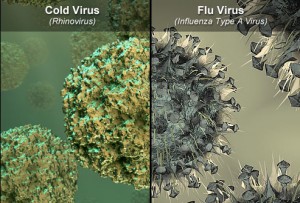Chemist.net Cookie Policy : We use cookies to enhance your user experience. To find out more please view our cookie policy
Spot the Difference: Do you know the difference between a cold and the flu?
 An estimated one third of Britons wrongly think that flu is just a bad cold. Although many symptoms of cold and flu overlap, they are very different so it is essential to understand which illness you have.
An estimated one third of Britons wrongly think that flu is just a bad cold. Although many symptoms of cold and flu overlap, they are very different so it is essential to understand which illness you have.Common symptoms of a cold include a runny nose, blocked nose, sore throat, sneezing and coughing, but you may also develop a mild fever, earache, tiredness and headache. Symptoms develop over one or two days and gradually get better after a few days, although some colds can last for up to two weeks.
Flu usually comes on much more quickly than a cold, and common symptoms include fever or chills, muscle aches and pains, sweating, feeling exhausted, dry, chesty cough and sneezing. Flu symptoms appear one to three days after infection and most people recover within a week, although fatigue may last longer (up to two or three weeks). Flu can cause serious respiratory complications such as bronchitis and pneumonia, especially in at-risk groups, including people over 65, people with diabetes, serious heart or chest complaints (including asthma) or serious kidney or liver disease, people with lowered immunity due to disease or medical treatment and those who have had a stroke or transient ischemic attack (TIA).
The table below gives a brief summary of the differences between colds and the flu:
| Cold | Flu | |
| Fever | Sometimes | Common: higher than 38°C and lasts 3-4 days |
| Headache | Sometimes | Common |
| General aches & pains | Common: mild | Common: often severe |
| Fatigue / weakness | Common: quite mild | Common: can last up to 2-3 weeks |
| Stuffy nose | Common | Sometimes |
| Sneezing | Common | Sometimes |
| Sore throat | Common | Sometimes |
| Chest discomfort /cough | Common: mild to moderate, often a hacking cough | Common: can become severe. |
| Complications | Sinus congestion or earache | Bronchitis or pneumonia, which can be life threatening. |